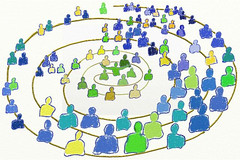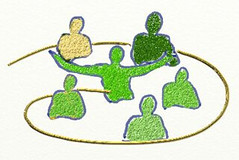“Look Up” Your Strong Ties, Connect to Your Weak Ties
Post by Christopher Allen. original layout
A blog on social software, collaboration, trust, security, privacy, and internet tools by Christopher Allen.
 (by Christopher Allen with Elyn Andersson and Shannon Appelcline)
Two years ago, the Bainbridge Graduate Institute (www.BGI.edu) faculty gathered to radically reinvent their sustainable business curriculum for the next decade. Our goal was not only to update course content, but also to significantly update how the material was taught. We wished to make our teaching process (our pedagogy) more interactive and also more effective for students graduating into a 21st-century work environment, where people increasingly work in teams-both online and offline.
(by Christopher Allen with Elyn Andersson and Shannon Appelcline)
Two years ago, the Bainbridge Graduate Institute (www.BGI.edu) faculty gathered to radically reinvent their sustainable business curriculum for the next decade. Our goal was not only to update course content, but also to significantly update how the material was taught. We wished to make our teaching process (our pedagogy) more interactive and also more effective for students graduating into a 21st-century work environment, where people increasingly work in teams-both online and offline. With Google+ almost two weeks into its test phase, conversation about this new social network service seems to be going in circles.
Literally.
That’s because Circles is the Google+ feature that users are generating the most buzz about. It’s Google’s answer to the problem of organizing your social graph online.
If you’re not familiar with a social graph it’s a map of everyone you know and how they are related to you.
With Google+ almost two weeks into its test phase, conversation about this new social network service seems to be going in circles.
Literally.
That’s because Circles is the Google+ feature that users are generating the most buzz about. It’s Google’s answer to the problem of organizing your social graph online.
If you’re not familiar with a social graph it’s a map of everyone you know and how they are related to you. In my first article in this series I talked about community numbers: how the sizes of groups ultimately affect their success (or failure). However what I discussed only offers up the most rudimentary explanation of the dynamics, and that is because typically not all of the members of a group are equally involved.
In order to better define who constitutes the tightly-knit "participant community" upon which the group thresholds act, we have to study power laws which let us measure the intensity of individuals' involvement in a group.
In my first article in this series I talked about community numbers: how the sizes of groups ultimately affect their success (or failure). However what I discussed only offers up the most rudimentary explanation of the dynamics, and that is because typically not all of the members of a group are equally involved.
In order to better define who constitutes the tightly-knit "participant community" upon which the group thresholds act, we have to study power laws which let us measure the intensity of individuals' involvement in a group. In my previous post, I talked about the limits on sizes of tightly-knit communities. These group limits are closely related to a number of interesting personal limits, and are often confused with them.
Unlike the group limits, personal limits actually measure something different: the number of connections that an individual can hold. They're yet another thing that you must consider when thinking about communities of people.
Personal Limits The Support Circle: This is the number of individuals that you seek advice, support, or help from in times of severe emotional or financial stress.
In my previous post, I talked about the limits on sizes of tightly-knit communities. These group limits are closely related to a number of interesting personal limits, and are often confused with them.
Unlike the group limits, personal limits actually measure something different: the number of connections that an individual can hold. They're yet another thing that you must consider when thinking about communities of people.
Personal Limits The Support Circle: This is the number of individuals that you seek advice, support, or help from in times of severe emotional or financial stress. We often think of communities as organic creatures, which come into existence and grow on their own. However, the truth is they are fragile blossoms. Although many communities surely germinate and bloom on their own, purposefully creating communities can take a tremendous amount of hard work, and one factor their success ultimately depends upon is their numbers.
If a community is too small you'll often have insufficient critical mass to sustain it.
We often think of communities as organic creatures, which come into existence and grow on their own. However, the truth is they are fragile blossoms. Although many communities surely germinate and bloom on their own, purposefully creating communities can take a tremendous amount of hard work, and one factor their success ultimately depends upon is their numbers.
If a community is too small you'll often have insufficient critical mass to sustain it. Last May I did an abbreviated version of my Dunbar Number talk at MeshForum 2006. A MP3 podcast of that talk is now available at IT Conversations or can be downloaded here (10mb).
If you'd like to follow along, here is a pdf copy of my presentation sides (10mb).
Biggest addition to what I've written about before is some discussion about different kinds of social software and what what size groups they seem to be appropriate for.
Last May I did an abbreviated version of my Dunbar Number talk at MeshForum 2006. A MP3 podcast of that talk is now available at IT Conversations or can be downloaded here (10mb).
If you'd like to follow along, here is a pdf copy of my presentation sides (10mb).
Biggest addition to what I've written about before is some discussion about different kinds of social software and what what size groups they seem to be appropriate for. In yesterday's All Things Considered, NPR commentator Jake Halpern questions why you feel like you have a relationship with the characters in your favorite TV shows. His answer: "That's because you do." This idea is interesting not just to help us understand how we relate to imaginary characters, but also to correlate with our own understanding of Dunbar Number relationship limits and how they might relate to this concept.
In his commentary, Bostonian Jake Halpern considers two academic ideas, "belongingness theory" and "para-social relationships", and how they affect the relationships we develop with television characters.
In yesterday's All Things Considered, NPR commentator Jake Halpern questions why you feel like you have a relationship with the characters in your favorite TV shows. His answer: "That's because you do." This idea is interesting not just to help us understand how we relate to imaginary characters, but also to correlate with our own understanding of Dunbar Number relationship limits and how they might relate to this concept.
In his commentary, Bostonian Jake Halpern considers two academic ideas, "belongingness theory" and "para-social relationships", and how they affect the relationships we develop with television characters. In my post about the Dunbar Number I offered some evidence on the levels of satisfaction of various group sizes based on some empirical data from online games. There I was able to show that even though the Dunbar Number might predict a mean group size of 150 for humans, that in fact for non-survival oriented groups the mean was significantly less, probably between 60 to 90.
I also offered a second hypothesis, that there is a dip in satisfaction level of groups at around the size of 15.
In my post about the Dunbar Number I offered some evidence on the levels of satisfaction of various group sizes based on some empirical data from online games. There I was able to show that even though the Dunbar Number might predict a mean group size of 150 for humans, that in fact for non-survival oriented groups the mean was significantly less, probably between 60 to 90.
I also offered a second hypothesis, that there is a dip in satisfaction level of groups at around the size of 15. As someone who now has over 171 professional "connections" in my LinkedIn Profile, 198 "friends" on Orkut, many more non-intersecting friends and acquaintances on Tribe.Net, LiveJournal, and other social networking services, as well as a plethora of correspondents that I only interact with via email, I am trying reconcile a mismatch between my connections and my own Dunbar Number.
How do I maintain meaningful relationships with over 300 people?
As someone who now has over 171 professional "connections" in my LinkedIn Profile, 198 "friends" on Orkut, many more non-intersecting friends and acquaintances on Tribe.Net, LiveJournal, and other social networking services, as well as a plethora of correspondents that I only interact with via email, I am trying reconcile a mismatch between my connections and my own Dunbar Number.
How do I maintain meaningful relationships with over 300 people? Lately I've been noticing the spread of a meme regarding "Dunbar's Number" of 150 that I believe is misunderstanding of his ideas.
The Science of Dunbar's Number Dunbar is an anthropologist at the University College of London, who wrote a paper on Co-Evolution Of Neocortex Size, Group Size And Language In Humans where he hypothesizes:
... there is a cognitive limit to the number of individuals with whom any one person can maintain stable relationships, that this limit is a direct function of relative neocortex size, and that this in turn limits group size .
Lately I've been noticing the spread of a meme regarding "Dunbar's Number" of 150 that I believe is misunderstanding of his ideas.
The Science of Dunbar's Number Dunbar is an anthropologist at the University College of London, who wrote a paper on Co-Evolution Of Neocortex Size, Group Size And Language In Humans where he hypothesizes:
... there is a cognitive limit to the number of individuals with whom any one person can maintain stable relationships, that this limit is a direct function of relative neocortex size, and that this in turn limits group size .